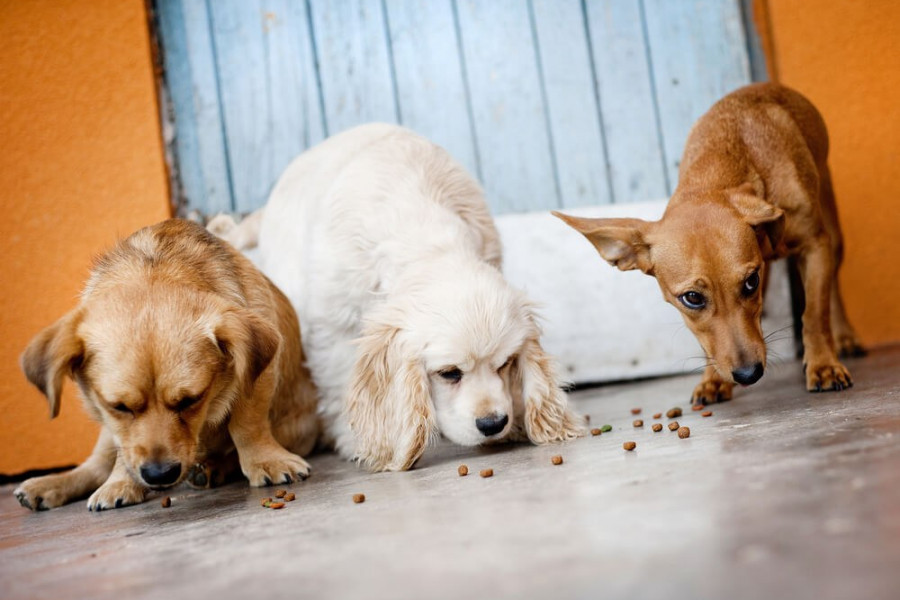The Basics of How Your Dog Digests Food

Ever wondered if your dog digests his food in the same way you do? Interestingly, dogs have the shortest system of any mammals. It takes around 9 hours for the whole process (depending on age, health and size of dog). Puppies take even less time. Knowing a bit about how your dog’s digestion process works can help you tell if something is amiss. So here are the basic facts about how your dog digests his food every day.
Step 1: Mouth to Esophagus
The mouth isn’t really part of the digestive system, but it’s where things start. Your dog’s salvia helps carry the food into the esophagus to get to the stomach. In the esophagus, muscles along the wall push food down towards the stomach.
Step 2: The Stomach
Next the food goes past the cardiac sphincter and into the stomach where gastric folds along the wall help grind and digest food. Hydrochloric acids and enzymes start to break down any large pieces your dog swallowed – particularly big chucks of meat or bone. This is where your dog may regurgitate if the pieces that were swallowed are too big for the stomach to handle. If you don’t stop him, your dog will just eat it back up – all part of the process and totally normal (unless he threw up a foreign object!).
Food will not be completely digested when it leaves the stomach. Instead it’s become “chyme” an acidic mixture of partly digested food and gastric juices that’s ready to move on to the…
Step 3: Small Intestine
The main part of digestion happens in the small intestine, which is roughly three times the length of your dog’s body. There are three parts to the small intestine. It is in the small intestine where the food will be broken down into its simplest form and will pass through the walls into your dog’s blood. By-products will be carried to the liver, and fat is absorbed into lymph vessels and then into the bloodstream. The small intestine has three parts:
1. The duodenum. The gallbladder (bile duct) and pancreas (pancreatic duct) are attached to this piece as well as the stomach. Enzymes and other fluids are produced by the liver and pancreas and pass through these two ducts to mix with the food and continue digestion.
2. The jejunum. Next, food goes through the second part of the small intestine which is covered with villi – small projections that add surface area so that nutrients can be absorbed as the chyme passes through.
3. Ileum. Finally, what’s left passes through this last portion and on to the…
Step 4: Large Intestine
Once at the large intestine, all that is left is waste. The large intestine’s main job is to remove access water from feces as needed. There is some fermentation of dietary fiber as well, which can cause gas. From the large intestine, waste enters the colon (which is actually part of the large intestine) and then leaves your dog’s body though the anus and rectum.
Large Breed Dogs Have Some Differences!
While all dogs have basically the same digestive system, it turns out there are some differences between small and large breed dogs. A study done by veterinary researchers in France found that in large breed dogs, the weight of the intestines is only 3 percent of their body weight. In small dogs, it’s 7 percent. This equates to less intestinal area for digestion and absorption of nutrients.
In addition they found that in large breed dogs, food stays longer in the colon, which gives more time for the bacteria in the colon to ferment food. This equates to more by-products that cause more water in the colon and ultimately more watery feces. It can also cause them to have to go more frequently than small dogs.
While it may sound relatively simple, digestion is a complex process where many things can cause problems. A key to healthy digestion is proper nutrients. We have all experienced upset stomachs when we eat too much sugar, fat or not enough protein. The same things effect our dogs. Knowing a bit about their system can also help you keep track of your dog’s health better. For example, now that you know digestion takes the average dog just 9 hours, if your dog hasn’t gone to the bathroom in 18 hours, there may be something wrong. The more you know how your dog’s body functions, the easier it will be for you to tell when something is not functioning as it should.
